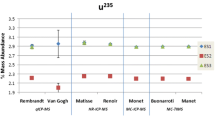Abstract
The 6th Collaborative Materials Exercise, CMX-6, was organized by the Nuclear Forensic International Technical Working Group in 2018 and 2019. Two exercise samples, which had classical and nuclear forensic components, were distributed to nuclear forensic (NF) laboratories throughout the world. The goal of the exercise was to enable the NF laboratories to practice their capabilities under a realistic scenario, and share their experience in an open forum. Here we present the use of laser ablation triple quadrupole inductively coupled plasma mass spectrometry for the nuclear forensic examination of uranium and plutonium contaminated materials in CMX-6. Similarity or dissimilarity of exercise samples was established though trace element analysis and uranium and plutonium isotope ratio measurements.







Similar content being viewed by others
References
Almirall JR, Trejos T (2016) Applications of LA-ICP-MS to forensic science. Elements 12:335–340
Subedi K, Trejos T, Almirall J (2015) Forensic analysis of printing inks using tandem laser induced breakdown spectroscopy and laser ablation inductively coupled plasma mass spectrometry. Spectrochim Acta B 103–104:76–83
Sylvester PJ, Jackson SE (2016) A brief history of laser ablation inductively coupled plasma mass spectrometry (LA-ICP-MS). Elements 12:307–310
Neufeld LM (2004) Introduction to the LA-ICP-MS for analysis of forensic samples. Agilent application note. https://www.agilent.com/cs/library/applications/5989-1565EN.pdf
INTERNATIONAL ATOMIC ENERGY AGENCY (2018) Development of a national nuclear forensic library: a system for the identification of nuclear or other radioactive material out of regulatory control. IAEA, Vienna
ASTM E2330-12 (2012) Standard test method for determination of concentrations of elements in glass samples using inductively coupled plasma mass spectrometry (ICP-MS) for forensic comparisons. ASTM International, West Conshohocken
Donnard A, Pottin A-C, Pointurier F, Pecheyran C (2015) Determination of relative rare earth element distributions in very small quantities of uranium ore concentrates using femtosecond UV laser ablation—SF-ICP-MS coupling. J Anal At Spectrom 12:2420–2428
Crain JS, Gallimore DL (1992) Determination of trace impurities in uranium oxides by laser ablation inductively coupled plasma mass spectrometry. J Anal At Spectr 7:605–610
Jovanovic SV, Kell T, El-Haddad J, Cochrane C, Drummond C, El-Jaby A (2020) Trace analysis of uranium ore concentrates using laser ablation inductively coupled plasma mass spectrometry for nuclear forensics. J Radioanal Nucl Chem 323:831–838
Varga Z, Suranyi G (2007) Production date determination of uranium-oxide materials by inductively coupled plasma mass spectrometry. Anal Chim Acta 599:16–23
Varga Z, Wallenius M, Mayer K (2010) Age determination of uranium samples by inductively coupled plasma mass spectrometry using direct measurement and spectral deconvolution. J Anal At Spectrom 25:1958–1962
Jovanovic SV, Weber PK, Pidduck AJ, Gaffney AM, Girard P, Pointurier F, Hedberg M, Simons AJ, Stebelkov V, Kell T, Knight K, Parsons-Davis T, Kristo M, Williams RW, Treinen KC, Montgomery NJ, King J et al (2020) Uncovering uranium isotopic heterogeneity of fuel pellets from the fifth collaborative materials exercise of the Nuclear Forensics International Technical Working Group. J Radioanal Nucl Chem 326:1853–1866
Krachler M, Varga Z, Nicholl A, Wallenius M, Mayer K (2018) Spatial distribution of uranium isotopes in solid nuclear materials using laser ablation multi-collector ICP-MS. Microchem J 140:24–30
Burger S, Riciputi LR (2009) A rapid isotope ratio analysis protocol for nuclear solid materials using nano-second laser-ablation time-of-flight ICP-MS. J Environ Radioact 100:970–976
Jovanovic SV, Dimayuga I, St-Amant N, Galea R (2020) Non-proliferation nuclear forensics: Canadian perspective. The American Society of Mechanical Engineers, New York
Schwantes JM, Marsden O (2021) After action report celestial sconis: ITWG CMX-6. s.l. in press
Alangi N, Mukherjee J, Anupama P, Verma MK, Chakravarthy Y, Padmanabhan PVA, Das AK, Gantayet LM (2011) Liquid uranium corrosion studies of protective yttria coatings on tantalum substrate. J Nucl Mater 410:39–45
Kim C-S, Kim C-K, Martin P, Sansone U (2007) Determination of Pu isotope concentrations and isotope ratio by inductively coupled plasma mass spectrometry: a review of analytical methodology. J Anal At Spectrom 22:827–841
Tanner SD, Li C, Vais V, Baranov VI, Bandura DR (2004) Chemical resolution of Pu+ from U+ and Am+ using a band-pass reaction cell inductively coupled plasma mass spectrometer. Anal Chem 76:3042–3048
Guorgiotis A, Granet M, Isnard H, Nonell A, Gautier C, Stadelmann G, Aubert M, Durand D, Legand S, Chartier F (2010) Simultaneous uranium/plutonium separation and direct isotope ratio measurements by using CO2 as the gas in a collision/reaction cell based MC-ICPMS. J Anal At Spectrom 25:1939–1945
Author information
Authors and Affiliations
Corresponding author
Additional information
Publisher's Note
Springer Nature remains neutral with regard to jurisdictional claims in published maps and institutional affiliations.
Supplementary Information
Below is the link to the electronic supplementary material.
Rights and permissions
About this article
Cite this article
Jovanovic, S.V., Kell, T. Nuclear forensic analysis with laser ablation inductively coupled plasma mass spectrometry in CMX-6. J Radioanal Nucl Chem 329, 319–326 (2021). https://doi.org/10.1007/s10967-021-07773-1
Received:
Accepted:
Published:
Issue Date:
DOI: https://doi.org/10.1007/s10967-021-07773-1




